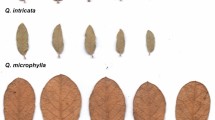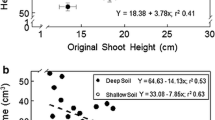Abstract
Plants growing in extreme habitats, such as deserts, are expected to show high plasticity (variability) in life history parameters to compensate for the unpredictability of their environment. In this study variability in life history parameters and possible sources of variability were investigated in four serotinous (= seed retaining) plant species from the Namib Desert.Blepharis grossa, Geigeria alata, Geigeria ornativa andPetalidium setosum were studied in a mosaic of spatio-temporal environmental conditions represented by three sites and three rain seasons. The coefficient of variation and whether or not significant differences occurred between environmental conditions were used to determine the most variable species and parameters. The most variable species was the strictly annualB. grossa, which might be related to its life form strategy and poor competitive ability as a pioneer species. Life history parameters which responded most frequently to varying environmental conditions were source pool, flowering time and seed production. Seedling density was influenced by the source pool and intensity of rainfall, seedling establishment by timing and intensity of rain events, as well as by seed mass. Although it was expected that high within population variability in life history parameters would also result in a response to differing environmental conditions, there was no direct correlation. Variable responses in life history parameters in most species were caused by differences in site condition as well as by differences in seasons, especially with regard to timing and intensity of rain events.
Similar content being viewed by others
References
Angevine, M. W. & Chabot, B. F. 1979. Seed germination syndromes in higher plants. In: O. T.Solbrig, S.Jain, G.B.Johnson & P. H.Raven (eds.), Topics in Plant Population Biology, pp. 186–206. Columbia Press, New York.
Arnon, I., 1972. Crop production in dry regions. Vol. I: Back-ground and Principles. Leonard Hill, London.
Aronson, J. & Shmida, A. 1992. Plant species diversity along a mediterranean-desert gradient and its correlation with interannual rainfall fluctuations. J. Arid. Env. 23: 235–247.
Baker, H. G. 1972. Seed weight in relation to environmental conditions in California. Ecology 53 997–1010.
Beatley, J. C. 1967. Survival of winter annuals in the northern Mojave Desert. Ecology 48: 745–750.
Beatley, J. C. 1974. Effects of rainfall and temperature on the distribution and behaviour ofLarrea tridentata (creosote bush) in the Mojave Desert of Nevada. Ecology 55: 245–261.
Bertiller, M. B., Beeskow, A. M. & Coronato, F. 1991. Seasonal environmental variation and plant phenology in arid Patagonia (Argentinia). J. Arid Env. 21: 1–11.
Bond, W.J. 1985. Canopy-stored seed reserves (serotiny) in Cape Proteaceae. S. Afr. J. Bot. 51: 181–186.
Bond, W., Vlok, J. & Viviers, M. 1984. Variation in seedling recruitment of Cape Protaceae after fire. J. Ecol. 72 209–221.
Bradstock, R. A. & Meyrscough, P. J. 1981. Fire effects on seed release and the emergence and establishment of seedlings inBanksia ericifolia L.F. Aust. J. Bot. 29: 521–531.
Chesson, P. L. 1986. Environmental variation and coexistence of species. In: J.Diamond & T. J.Case (eds.), Community Ecology, pp. 240–266, Harper & Row, New York.
Cloudsley-Thompson, J.L. & Chadwick, M.J., 1964. Life in Deserts. Dufour Editions, Philadelphia.
Cowling, R. M. & Lamont, B. B., 1985. Variation in serotiny of threeBanksia species along a climatic gradient. Aust. J. Ecol. 10: 345–350.
Davies, S. J. J. F., 1973. Environmental variables and the biology of native Australian animals in the mulga lands. Trop. Grasslands 7: 127–134.
Evenari, M. 1962. Plant physiology and arid zone research. The problems of the arid zone. Proc. Paris Symposium, pp. 175–195, UNESCO, Paris.
Evenari, M. 1980. The history of germination research and the lesson it contains for today. Israel J. Bot. 29: 4–21.
Evenari, M. 1984. Seed physiology: from ovule to maturing seed. Bot. Rev. 50: 143–170.
Evenari, M. & Gutterman, Y. 1966. The photoperiodic response of some desert plants. Z. Pflanzenphysiol. 54: 7–27.
Evenari, M., Shanan, L. & Tadmor, N. 1982. The Negev-The Challenge of a Desert. Harvard Univ. Press, Cambridge.
Fenner, M. 1987. Seedlings. New Phytology 106: 35–47.
Fowler, N. L. 1988. What is a safe site?: Neighbour, litter, germination date, and patch effects. Ecology 69: 947–961.
Fox, G. A. 1990. Perennation and the persistence of annual life histories. Am. Nat. 135: 829–840.
Friedman, J., Orshan, G. & Ziger-Cfir, Y. 1977. Suppression of annuals byArtemisia herba-alba in the Negev Desert of Israel. J. Ecol. 65: 413–426.
Friedman, J., Gundermann, N. & Ellis, N. 1978. Water response of the hygrochastic skeletons of the true Rose of Jericho. Oecologia 32: 298–301.
Grime, J. P. 1979. Primary Strategies in Plants Trans. Bot. Soc. Edinb. 43: 151–160.
Grime, J. P. 1989. Seed banks in ecological perspective. In M. A.Leck V. T.Parker & R. L.Simpson (eds.), Ecology of Soil Seed Banks, pp. 15–22, Acad. Press, New York.
Günster, A. 1992. Aerial seed banks of the central Namib: Distribution of serotinous species in relation to climate and habitat. J. Biogeography 18: 563–572.
Günster, A. 1993a. Ökologische Untersuchungen zur zeitverzögerten Samenverbreitung in der zentralen Namib. Doctoral thesis (German with English Summary), University of Münster, Münster.
Günster, A. 1993b. Does the timing and intensity of rains affect resource allocation in serotinous desert plants? Acta Oecologica 8: 153–159.
Günster, A. 1993c. Microhabitat differentiation among serotinous plants in the Namib Desert. J. Veg. Sci. 4: 585–590.
Günster, A. in press. Seed bank dynamics-longevity, viability and predation of seeds of serotinous plants in the central Namib. J. Arid Env., in press.
Gutterman, Y. 1986. Are plants which germinate and develop during winter in the Negev Desert Highlands of Israel, winter annuals? In: Z.Dubinsky & Y.Steinberger (eds.), Environmental Quality and Ecosystem Stability, Vol. IIIA/B, pp. 135–244, Bar Ilan Univ. Press, Ramat-Gan, Israel.
Haig, D. & M.Westoby 1988 Inclusive fitness, seed resources and maternal care. In J. & L.Lovett Doust (eds.), Plant Reproductive Ecology, pp. 60–79, Oxford Univ. Press, Oxford, New York.
Harper, J.L. (1977). Population Biology of Plants. Academic Press London, New York, San Francisco, pp. 892.
Harper, J. L., Williams, J. T. & Sagar, G. A. 1965 The behaviour of seeds in soil I: The heterogeneity of soil surfaces and its role in determining the establishment of plants from seed. J. Ecol. 53: 273–286.
Inouye, R. S. 1991. Population biology of desert annual plants. In G. A.Polis (ed.), The Ecology of Desert Communities, pp. 25–54, Univ. of Arizona Press, Tuscon.
Jurado, E. & Westoby, M. 1992. Seedling growth in relation to seed size among species of arid Australia. J. Ecol 80: 407–416.
Kassas, M. 1966. Plant life in deserts. In: E.Hills (ed.), Arid Lands: A Geographical Appraisal, pp. 145–186, Methuen, London.
Koller, D. 1972. Environmental control of seed germination. In: T. T. Kozlewski (ed.), Seed Biology, pp. 1–102, Vol. II, New York, London.
Lamont, B. B. 1991. Canopy seed storage-what's in a name? Oikos 60: 266–268.
Lee, T. D. 1988. Patterns of fruit and seed production. In: J. L.Lovett Doust & L.Lovett Doust (eds.), Plant Reproductive Ecology-Patterns and Strategies, pp. 179–202, Oxford Univ. Press, Oxford.
LeMaitre, D. C. 1984, Current interpretations of the term serotiny, S. Afr. J. Sci. 81: 284–290.
Loria, M. & Noy-Meir, I. 1980. Dynamics of some annual populations in a desert loess plain. Israel J. Bot. 28: 211–225.
Marshall, D. L., Fowler, N. L. & Levin, D. A. 1985. Plasticity in yield components in natural populations of three species ofSesbania. Ecology 753–761.
Maun, M. A. & Cavers, P. B. 1971. Seed production inRumex crispus I. The effects of removal of cauline leaves at anthesis. Canadian J. Bot. 49: 1123–1130.
Mayer, A. M. 1986. How do seeds sense their environment? Some biochemical aspects of the sensing of water potential, light and temperature. Israel J. Bot. 35: 3–16.
Mazer, S. J. 1990. Seed mass of Indiana dune general and families: taxonomic and ecological correlates. Evolutionary Ecology 4: 326–357.
Meyer, P. G. 1961. Vermischte Notizen zu den Acanthaceen und Euphorbiaceen Südwestafrikas. Mitt. Bot. Staatsamml. München 49: 145–160.
Monson, R. K. & Szarek, S. R. 1981. Life cycle characteristics ofMachaeranthera gracilis (Compositae) in desert habitats. Oecologia 49: 50–55.
Mott, J. J. 1972. Germination studies on some annual species from an arid region of Western Australia. J. Ecol. 60: 293–304.
Mueller-Dombois, D. & Ellenberg, H. 1974. Aims and Methods of Vegetation Ecology. John Wiley & Sons, New York, London, Sydney, Toronto.
Muller, C. H. 1953. The association of desert annuals with shrubs. Am. J. Bot. 40: 53–60.
Negbi, M. & Evenari, M. 1962. The means of survival of some desert summer annuals. In: Plant-work relationships in arid and semi-arid conditions. Proc. Madrid Symp. UNESCO, pp. 49–257.
Porath, D. & Adar, E. M. 1992. The role of light and water in the establishment of mullein (Verbascum sinaiticum andV. fruticulosum) in a gravel wadi bed. J. Arid. Env. 22: 231–244.
Primack, P. B. 1978. Regulation of seed yield inPlantago. J. Ecol. 66: 835–847.
Rice, E. L. 1984. Allelopathy. Acad. Press, New York, London.
Sankary, M. N. & Barbour, M. G. 1972. Autecology ofHaloxylon articulatum in Syria. J. Ecol. 60: 697–712.
Scholz, H. 1968. Die Böden der Halbwüste Sdwestafrikas. Zeitschr. Pflanzenern. und Bodenkunde 120: 105–118.
Sherbrocke, W. C. 1989. Seedling survival and growth of a Sonoran desert shrub, jojoba (Simmondsia chinensis) during the first 10 years. Southwest. Nat. 34: 421–424.
Shreve, F. 1951. Vegetation of the Sonoran Desert, Carnegie Institute of Washington Publication No. 591, Washington D.C.
Sokal, R. R. & Rohlf, F. J. 1981. Biometry. W. H. Freeman and Company, New York.
Solbrig, O. T. 1976. Life forms and vegetation patterns in desert regions. In: J. R.Goodin & O. K.Northinton (eds.), Arid Plant Resources, pp. 82–95. Texas Tech Univ., Lubbock.
Solbrig, O. T., Barbour, M. A., Cross, J., Goldstein, G., Lowe, C. H., Morello, J. & Yang, T. W. 1977. The strategies and community patterns of desert plants. In: G. H. Orians & O. T. Solbrig (eds.), Convergent Evolution in Warm Deserts pp. 67–106, Stroudsburg.
Stephenson, A. G. 1981. Flower and fruit abortion: proximate causes and ultimate functions. Ann. Rev. Ecol. Syst. 12: 253–279.
Stopp, K. 1958. Die verbreitungshemmenden Einrichtungen der südafrikanischen Flora. Botan. Studies 8, Jena, pp. 103.
Tevis, L. 1958. Germination and growth of ephemerals induced by sprinkling a sandy desert. Ecology 39: 681–687.
Thompson, K. 1987. Seeds and seed banks New Phytol. 106: 23–34.
VanRooyen, M. W., Grobbelaar, N., Theron, G. K. & VanRooyen, N. 1992. The ephemerals of Namaqualand: Effect of germination date on development of three species. J. Arid Env. 22: 51–66.
Venable, D. L. & Brown, J. S. 1988. The selective interactions of dispersal, dormancy, and seed size as adaptations for reducting risk in variable environments. Am. Nat. 131: 360–384.
Ward, J. D., Seely, M. K. & Lancaster, N. 1983. On the antiquity of the Namib. S. Afr. J. Sci. 79: 175–183.
Went, F. W. 1957. The experimental control of plants growth. Chronica Botanica, Waltham, Massachusetts.
Went, F. W. 1979. Germination and seedling behavior of desert plants. In D. W. Goodall & P. A. Perry (eds.), Arid Land Ecosystems, Vol. I, pp. 477–490, Cambridge.
Weiner, J. & Solbrig, O. T. 1984. The meaning and measurement of size hierarchies in plant populations Oecologia 61: 334–336.
Westoby, M., Jurado, E. & Leishman, M. 1992. Comparative evolutionary ecology of seed size. Trends Ecol. Evol. 7: 368–372.
Wiens, J. A. 1977. On competition and variable environments. Am. Sci. 65: 590–597.
Willson, M. F., 1983. Plant Reproductive Ecology. J. Wiley & Sons, New York, 282 pp.
Willson, M. F. & Price, P. W. 1980. Resource limitations of fruit and seed production in someAsclepias species. Can. J. Bot. 58: 2229–2233.
Zedler, P. H. 1986. Closed-cone conifers of the chaparral. Fremontia 14: 14–17.
Zohary, M. 1962. Plant Life of Palestine. Ronald Press Comp., New York, pp. 262.
Author information
Authors and Affiliations
Rights and permissions
About this article
Cite this article
Günster, A. Variability in life history parameters of four serotinous plants in the Namib Desert. Vegetatio 114, 149–160 (1994). https://doi.org/10.1007/BF00048394
Accepted:
Issue Date:
DOI: https://doi.org/10.1007/BF00048394




